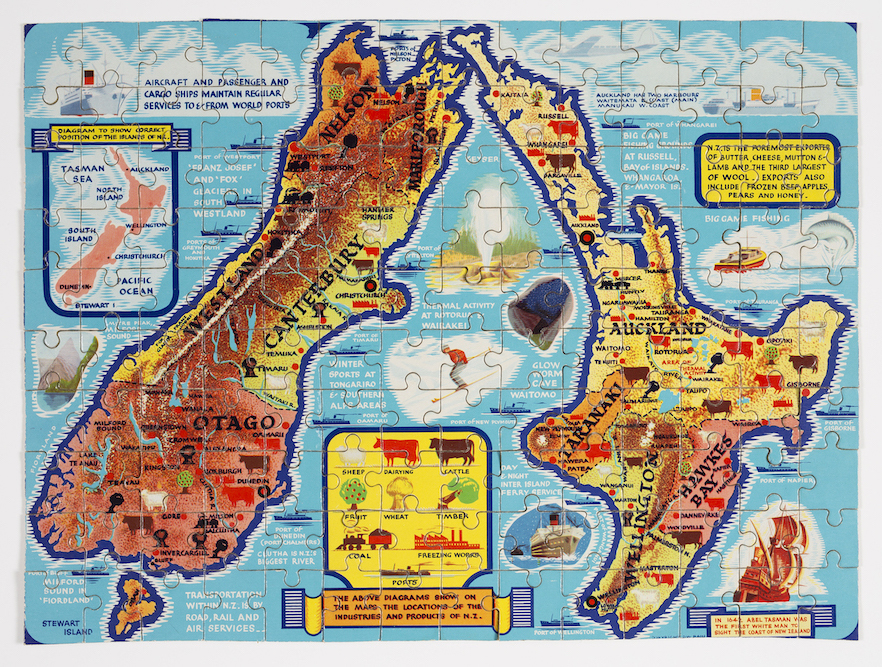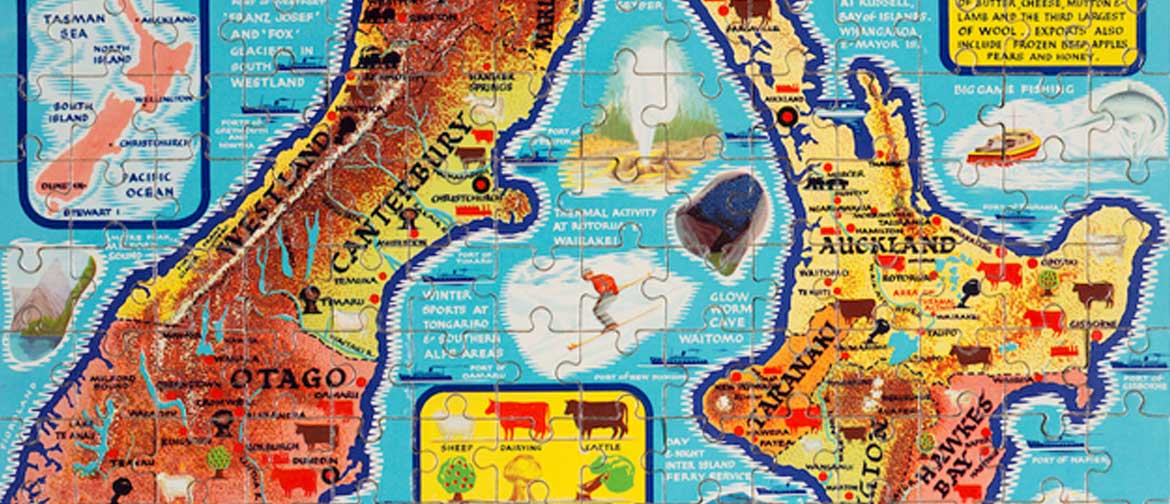Manufacture and Design
Founded in 1939, Thomas Holdsworth & Sons produced and imported puzzles and games for several generations of New Zealand children. The company made its first jigsaw puzzles to use up an overrun of calendars, which were glued to plywood and manufactured with a cutter adapted from an old sewing machine. In the 1950s they increasingly moved to making cardboard jigsaw puzzles, producing several with educational themes. This included one focusing on train and bus travel, and the example shown, depicting industries and products. The design was the work of Dudley Watson Bain (1909-1986). Auckland-born Bain was a commercial artist and his designs featured on a number of Holdsworth & Sons games and puzzles. He also illustrated a children’s book written by his wife Phyllis: Fairy Folks at Work, published by Holdsworth & Sons in 1925.
Message
The main message in the design is a celebratory one: that New Zealand is a world-leading exporter of butter, cheese, mutton and lamb. The completed puzzle shows the distribution of these industries across the country. Secondary themes are the importance of seaports and shipping (both coastal and international) in the national economy, and the range of tourism and recreation activities available, all based around natural features and resources.
Intent
A jigsaw puzzle provides entertainment. It can also help children learn, in this case about New Zealand’s industries and primary products. Completing it let children appreciate what their own region produced and how it compared to neighbouring districts. New Zealand in the 1950s remained one of Britain’s ‘offshore’ farms. The passive message of the puzzle reinforces what seemed to be the enduring nature of this connection. In this respect it unintentionally hints at the vulnerability of specialising in a small number of exports predominantly for a single overseas market.
Dudley Bain designed puzzles and games for Holdsworth & Sons during the 1950s. The design of this particular puzzle is attributed to him, but in the case of another board game called “Tour of New Zealand”, a game based on New Zealand towns and cities, it was actually copyrighted to him.
Holdsworth & Sons branded this puzzle as part of their “Instructional and Educational” series. In this way it appealed to parents and grandparents as a gift that had worth over and above the amusement value of regular jigsaws.

“Industries and Products of N.Z.” jigsaw, offset photomechanical print on cardboard, 274mm by 368mm. Donated by Luanne Gooch; Te Manawa Museums Trust, 2015/5/2.
Technique
The puzzle shows a map of New Zealand and uses various mapmaking conventions, but it is the work of a graphic designer rather than a cartographer. The two main islands are facing each other, to make best use of the puzzle’s space, and are depicted in the much-used Mercator projection. The map is not a plane or vertical view; it is slightly oblique, as if you are looking at it from an angle. Colours and symbols show the different regions and the location of various types of industry. A small inset map puts the main islands – labelled only as “North Island” and “South Island” – in correct relative position. Other panels explain the various symbols and draw additional attention to the scale of the country’s exports.
The labelled regions approximate those of the old 19th century provincial boundaries. The main ranges and hills are depicted using a pointillistic style. An actual cartographer would have used hachures, short lines the length and density of which indicate the steepness and direction of slope, to suggest the topography; the more conventional contour lines would have overloaded the design and drawn attention away from its main focus on industries and tourism.
Major river and lake systems are shown and named. Across the top part of the puzzle runs a horizon with clouds, along with passenger and cargo ships. In the 1950s these services, rather than aircraft, connected New Zealand to the rest of the world. A subsidiary theme depicts various tourist attractions. Icons related to skiing, fishing and other activities are spread across the puzzle, mimicking the style of early map makers filling up unknown areas. The icon in the lower right-hand corner interestingly references Abel Tasman’s sighting of New Zealand in 1642, rather than Cook’s in 1769.
References
Bain, D.W., fl. 1950s. Holdson’s Educational Tour of New Zealand. [Board game, 1950s?]. Eph-f-Games-1950s-01. Alexander Turnbull Library.
Holdson Limited New Zealand, www.holdson.com
Context
The puzzle was one of several donated to Te Manawa by Luanne Moira Gooch (née Russ) in 2015. It was purchased in the early 1960s when she was a child in New Plymouth. This region of the map featured a silhouette of a large red cow, the symbol indicating an important centre of the dairy industry; Mt Taranaki is depicted by its former name of “Egmont”. Used by another generation in Palmerston North, this city’s name is awkwardly positioned to make space for the Wellington Province label. The icon for wheat growing near Marton does not represent the economic base of the wider district very accurately.
Puzzles have an inbuilt redundancy; once completed they lose their challenge, though this may be rekindled if they are broken up and reattempted later on. In this instance there was no box with a picture of the completed puzzle for guidance. The outline of New Zealand’s main islands made for a recognisable pattern, and as the jigsaw had only 140 separate pieces, it was simple enough to be completed in a relatively short time. Frequent use of the puzzle led to wear and tear, resulting in damage by pieces being bent, scratched or lost altogether.
The puzzle dates from the 1950s. Since the 1890s the New Zealand economy, assisted by refrigeration technology, had developed within the British Empire as a supplier of primary produce for the United Kingdom. In 1930, 81% (by value) of New Zealand’s annual exports had gone to this single market. By 1950 this had fallen to 65%, declining to 56% in 1959. In 1963 the British government indicated that they intended to seek membership of the European Economic Community (EEC). France’s President Charles de Gaulle rebuffed them, but they finally gained membership in 1973. New Zealand exporters had to find new markets and produce other commodities. By 1990 only 7% of New Zealand exports by value went to the UK. The puzzle, offering a map of “industries and products,” in retrospect provides a snapshot of the end of an era in the country’s economic development.




